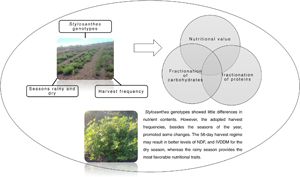Article contents
Yield and nutritive value of Stylosanthes spp. genotypes subjected to different harvest frequencies and seasons of the year
Published online by Cambridge University Press: 09 January 2024
Abstract

Productive and nutritional traits of forage species in various regions worldwide depend on different management strategies. This study aimed to evaluate the effects of harvest frequency (56, 77 and 98 days) and season of the year (rainy and dry) on the nutritional value and fractionation of carbohydrates and proteins of Stylosanthes genotypes (S. seabrana, S. scabra, S. mucronata and Stylosanthes spp. cv. Campo Grande). The experiment was conducted using a randomized complete block design with a split-plot arrangement and four repetitions. Contents of neutral detergent fibre (NDF), acid detergent fibre (ADF), in vitro digestible dry matter (IVDDM), condensed tannins and total phenolic compounds were influenced by the interaction of harvest frequency and season of the year. The 98-day harvest frequency resulted in lower IVDDM (579 g/kg) due to the high NDF and ADF concentrations during the rainy season. S. seabrana and S. scabra showed a higher proportion of A + B1 and B2 carbohydrate fractions, while the C fraction in the rainy season was greater in the Campo Grande, resembling S. seabrana. S. scabra displayed 15% of the crude protein in fraction A. The bromatological traits of Stylosanthes spp. did not decline sharply owing to plant age advancement, indicating these genotypes are suitable for forage production systems in tropical or semiarid regions.
Information
- Type
- Crops and Soils Research Paper
- Information
- Copyright
- Copyright © The Author(s), 2024. Published by Cambridge University Press
References
- 2
- Cited by


